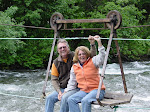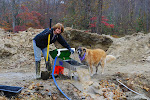 We had hoped and planned to throw the wet suits on again this visit and jump in the water with the manatees, but found the cold front that passed through the area the week of our visit, made the prospect of doing that a tad less than appealing. Sorry to say that, having done this before, and even though we LOVE doing it, we opted to stay warm and not get into the water with them this time around. But that doesn't mean we didn't see plenty of them or have the chance to get up close and personal. A visit to the Homosassa Springs State Park virtually guarantees that you will be able to observe the gentle giants in crystal clear water, and get within a few feet of them while you are in their presence.
We had hoped and planned to throw the wet suits on again this visit and jump in the water with the manatees, but found the cold front that passed through the area the week of our visit, made the prospect of doing that a tad less than appealing. Sorry to say that, having done this before, and even though we LOVE doing it, we opted to stay warm and not get into the water with them this time around. But that doesn't mean we didn't see plenty of them or have the chance to get up close and personal. A visit to the Homosassa Springs State Park virtually guarantees that you will be able to observe the gentle giants in crystal clear water, and get within a few feet of them while you are in their presence. Without a diver in the water beside them to show scale, it may be harder to get a sense of their size. In fact, they regularly weigh a ton or so. They move slowly, powered by an enormous round fluke at the back of the torpedo shaped body, and graze on "lettuce" and other aquatic vegetation found within their range. They are an amazing sight to behold. Of course, you know you can click on the pictures to enlarge them and give you a better look!
Without a diver in the water beside them to show scale, it may be harder to get a sense of their size. In fact, they regularly weigh a ton or so. They move slowly, powered by an enormous round fluke at the back of the torpedo shaped body, and graze on "lettuce" and other aquatic vegetation found within their range. They are an amazing sight to behold. Of course, you know you can click on the pictures to enlarge them and give you a better look!
 The state park is also home to thousands of Florida's native birds. While there are some "wild" birds that come and go as they please, the lion's share of theses birds are here because they have been hit by cars, boats, planes...or anything else that did them some harm. There are some with one wing broken or even missing, one leg, a missing eye, you name it. But in most cases, the birds have adapted so well, that unless you were paying attention to the park ranger as she goes around feeding the birds that need the most help, you may never realize the fact that these guys are "handicapped" in some way.
The state park is also home to thousands of Florida's native birds. While there are some "wild" birds that come and go as they please, the lion's share of theses birds are here because they have been hit by cars, boats, planes...or anything else that did them some harm. There are some with one wing broken or even missing, one leg, a missing eye, you name it. But in most cases, the birds have adapted so well, that unless you were paying attention to the park ranger as she goes around feeding the birds that need the most help, you may never realize the fact that these guys are "handicapped" in some way. Just at the edge of the preserve area of the park, the protected waters merge with the head waters of the Homasassa River in a basin which is very popular with manatee watching boats, private boats that are sight seeing and maybe doing some fishing, kayakers, snorkelers, and so on. Because the water is perfectly clear it would be the perfect place to find a "glass bottom" boat. There are tons of snapper, red fish, snook, ladyfish and black striped mullets and sheepshead. I didn't see any glass bottom boat on this day, but look closely at the photo below and you will clearly see a "bare boat charter," or at the very least, a "bare bottom" captain. Surely this is how Captain Larry got his start aboard Fitter out of Cape Coral, Florida.
Just at the edge of the preserve area of the park, the protected waters merge with the head waters of the Homasassa River in a basin which is very popular with manatee watching boats, private boats that are sight seeing and maybe doing some fishing, kayakers, snorkelers, and so on. Because the water is perfectly clear it would be the perfect place to find a "glass bottom" boat. There are tons of snapper, red fish, snook, ladyfish and black striped mullets and sheepshead. I didn't see any glass bottom boat on this day, but look closely at the photo below and you will clearly see a "bare boat charter," or at the very least, a "bare bottom" captain. Surely this is how Captain Larry got his start aboard Fitter out of Cape Coral, Florida.And speaking of Florida, for a while I was feeling quite guilty about post after post coming out of Florida. Having lived in the state myself for 5 plus years now, I suppose I thought the Florida subjects for the blog may not have the same appeal as posts from, say, the Yukon Territory, the gold fields and mountains of Alaska or even the endless and large animal-populated plains of Montana. But it seems I was wrong about that, thinking only about what was new and exciting to me and not so much what was new and exciting to all the readers. Now we are hearing just as much reader feedback as ever- all of it in the plus column. We have even been told by some "born and raised" Floridians that we have discovered and written about activity opportunities they were unaware of even after living their entire lives in Florida. So, as long as it works for you, we'll keep introducing you to things we may have seen or experienced before, so long as they are new and exciting and educational to you and yours....

 In this post I am including three new signs found along our travels in the area. Above, even though all the other critters at the Homasassa State Park are native Florida animals, clearly the hippo is a "naturalized citizen." You will see both the sign and the hippo in the photo if you look hard enough. This is not a sign you will see everywhere. The sign did not say, BEWARE, but it should have!!!
In this post I am including three new signs found along our travels in the area. Above, even though all the other critters at the Homasassa State Park are native Florida animals, clearly the hippo is a "naturalized citizen." You will see both the sign and the hippo in the photo if you look hard enough. This is not a sign you will see everywhere. The sign did not say, BEWARE, but it should have!!!And the sign below appeared on the door to the mens room at Frog's Landing Restaurant on the water at Cedar Key- a quaint little "drinking town with a fishing problem."
 Phrasing is everything. At the bait shack, you can "rent you bait" (how does that work??) and they apparently sell "live and frozen kayaks."
Phrasing is everything. At the bait shack, you can "rent you bait" (how does that work??) and they apparently sell "live and frozen kayaks." Below, Marilyn samples a fry from the fisherman's platter and, in the foreground, you get a look at my plate of roasted hard shell clams (little necks) in tomato, garlic and wine sauce. Cedar Key, unbeknownst to me and a big surprise to be sure, is the largest producer of hard shell clams in the country. They come straight from the flats to the restaurant on a daily basis, so I just had to enjoy a plate of them. I was not disappointed.
Below, Marilyn samples a fry from the fisherman's platter and, in the foreground, you get a look at my plate of roasted hard shell clams (little necks) in tomato, garlic and wine sauce. Cedar Key, unbeknownst to me and a big surprise to be sure, is the largest producer of hard shell clams in the country. They come straight from the flats to the restaurant on a daily basis, so I just had to enjoy a plate of them. I was not disappointed. Later, while we were sitting around outside at the end of another day of exploring, this box turtle crawled up for a visit. Even Abby enjoyed the visit, before we set the little guy off in the direction of safety.
Later, while we were sitting around outside at the end of another day of exploring, this box turtle crawled up for a visit. Even Abby enjoyed the visit, before we set the little guy off in the direction of safety.























































